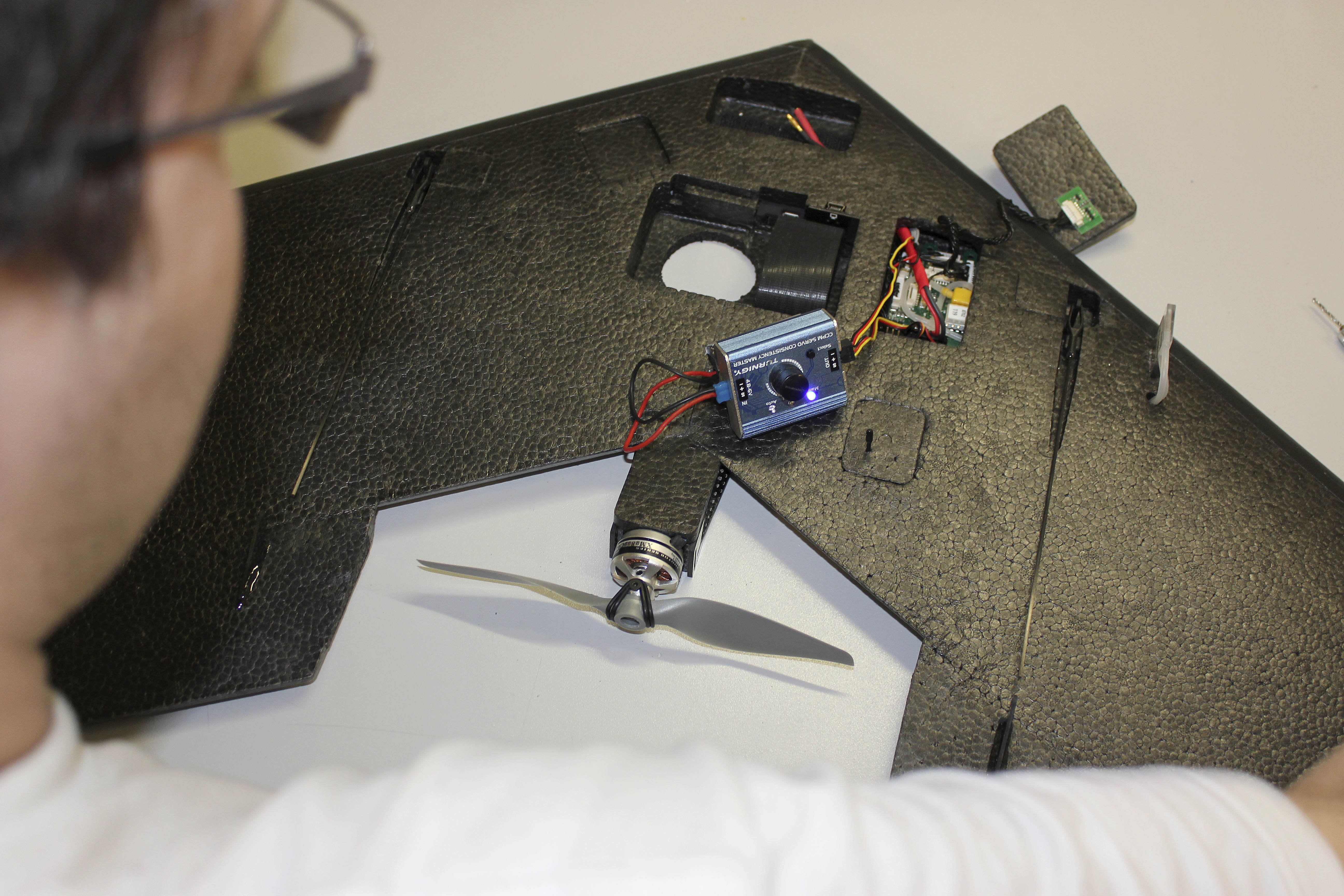Next generation of robots will have a gentle touch

The new field of soft robotics aims to produce robots made of materials which are more adaptable, flexible and less hazardous than traditional steel and hard plastic. Swiss institutions are at the forefront of research in this novel field.
Robots are becoming more and more a feature of everyday life. They are no longer to be found just in factories, tirelessly assembling auto parts, but also in the home, vacuuming the living room or mowing the lawn, and even in the children’s rooms, where a robot in the shape of a dinosaur or a dog might be seen entertaining the youngest members of the family.
All these robots have one thing in common: they have a rigid body, with a metal or plastic surface. This makes them robust, but also inflexible. They work accurately and without a break, but only in a precisely defined, very limited context.
What’s more, traditional “hard” robots can be a hazard to their human owners. Industrial robots have to be kept in protective cages so that people working on the shop floor don’t get too close to them and risk a blow from one of the fast-moving steel arms. Surgeons still have considerable reservations about the use of robots in the operating theatre, as they may cause slight injuries to the patient.
To make robots more flexible, adaptable and safe for humans to be around, the new research field of soft robotics has arisen in the past decade. Researchers in the field have been taking their cue from living organisms.
“People and animals have soft bodies. Some 90% of the body is soft. The adaptability of organisms has in fact a lot to do with the nature and shape of their bodies,” says Fumiya Iida, who heads the Bio-Inspired Robotics Lab at the Swiss Federal Institute of Technology Zurich (ETHZ).
Soft robotics is still in its infancy, however. “Soft robots can’t be built with existing technologies,” explains the Japanese researcher. “We have to invent everything from scratch, such as the materials, the sensors and motors that make up the robot.” Development of soft robots therefore involves not just robotics specialists, but materials scientists, chemists and biologists.
Sitting on a robot doesn’t sound too relaxing, does it? But if Massimo Vespignani has his way, in the future we may be relaxing on robotic sofas, and when we want something to eat, we’ll issue a command and the sofa will transform itself into a dining table and chair. A researcher at the Laboratory for Biorobotics in Lausanne, Vespignani is working on “Roombots”, a kind of modular robot which in the future could make this utopian vision a reality.
A single “Roombot” module consists of two round objects the size of a handball. The balls are linked by an axis, and each one contains a motor, a battery and programmable electronics. The single modules can be connected to other modules and taken apart again as desired. In this way Roombots can take on just about any form and adapt to the most varied requirements.
The greater the number of modules put together and the more complex the form of the assembled “Roombot”, the harder it is to programme it, Vespignani admits. “One single module is easy enough to control – something like a remote-controlled [toy] car. But if you put several modules together, you can no longer really predict how this complex entity will respond to programmed commands. You have to see by trial and error and then do all the adjustments required to make it work.”
Before you can install one of these robot sofas in your living room, the Roombots are going to need a soft shell. At the moment they are made mostly of hard plastic. The material for a shell that is soft and durable enough – and still does not impede the freedom of movement of the modules – has yet to be invented.
Artificial muscles for soft robot hands
One of the researchers developing components for soft robots is Jun Shintake, a doctoral student at the Laboratory for Intelligent Systems of the Federal Institute of Technology Lausanne (EPFL). He and his team are working on a dielectric elastomer activator (DEA), which is a kind of artificial muscle.
The device sounds complicated, but it doesn’t look like much – a soft, elastic, transparent strip of plastic film about the size of a human thumb. A black strip with special nanoparticles in the middle of the film gives it particular properties, however. Using an electric current, the plastic film can be made to contract or to spread out.
With two or more of these lengths of plastic, scientists can construct a soft robot hand which can grasp objects gently without damaging them. “Since this development is completely new, we don’t really know yet what the future applications will be,” says its inventor, Shintake. He could, however, readily imagine applications in space travel or medical prosthetics.
Developing new materials and components for soft robots is not the only challenge facing the researchers. When the exact dimensions of body parts and the angles of joints are known – as in the case of hard robots– it’s fairly easy to specify the movements in advance and to control the robot that way. But with robots that have a soft body, one that is even extendable, this becomes much more difficult.
The developers of Roombots are grappling with this problem as well. This type of robot from the Laboratory for Biorobotics in Lausanne does not actually have a predefined body, butrather is made up of a lot of small modules that users can combine into any shape they want. “Our dream is to build a robot that can turn itself from a chair into a sofa on command,” says project worker Massimo Vespignani.
Intelligent tentacles
Many living things have very soft bodies, yet have no difficulty in controlling those bodies and getting them to do particular things. One especially soft and dexterous animal is the octopus. The EU research project OCTOPUS IP is attempting to better understand the skilful movements of these slippery eight-armed creatures. Over the next few years, several research teams will be working together to build a robotic octopus which has the same capabilities as its natural counterpart.
Kohei Nakajima of Zurich University recently completed a sub-project of OCTOPUS IP. In a small aquarium in his lab we see a white tentacle made of silicon swinging to and fro. This tentacle is equipped with a number of sensors which measure the position of the different segments of the tentacle. With this silicon tentacle Nakajima has been able to show that an octopus arm is endowed with a certain amount of intelligence and a kind of short-term memory.
Since the tentacle is soft and flexible, stimuli caused by touch or movements in the water, for example, are propagated along its segments with a slight time lag. “There is a lot of information hidden in the dynamics of the movement of soft bodies. We can extract this information and use it for controlling the body. In that sense an octopus is like a floating brain without a cranium,” explains Nakajima. “One can even make calculations with it.”
Nakajima’s dream is to make a robot that can bend itself into any shape, like the frightening robot made of liquid metal in the film “Terminator 2”. Asked if that kind of robot might not make him feel uneasy, Nakajima laughs and says that the robot would imitate the movie monster only in terms of flexibility. He would endow his creation with very modest capabilities, so that no one would have anything to worry about.
Switzerland supports research projects in robotics through one of its National Centres of Competence in Research (NCCR).
NCCR Robotics coordinates various research projects at the Federal Institutes of Technology in Zurich (ETHZ) and Lausanne (EPFL), Zurich University and the Dalle Molle Institute for Artificial Intelligence. For the period from 2010 to 2014 the research unit has a budget of some CHF35 million to spend.
At NCCR Robotics there are currently five different projects under way:
– Bio-mimetic sensing, actuation, and mobility (robots based on living organisms)
– Interaction and Manipulation (man-machine communication)
– Prosthetic Robotics (medical applications)
– Distributed Robotics (modular robot systems)
– Robots for Daily Life (expanding use of robots in society)
In July a week-long international workshop on soft robotics and morphological computation was held at Monte Verità in Ticino. The organiser was Fumiya Iida, who leads the Bio-inspired Robotics Labs at the ETHZ. Some 100 scientists, mostly from the USA, Japan and Switzerland, attended this event.
(Translated by Terence MacNamee)

In compliance with the JTI standards
More: SWI swissinfo.ch certified by the Journalism Trust Initiative











You can find an overview of ongoing debates with our journalists here . Please join us!
If you want to start a conversation about a topic raised in this article or want to report factual errors, email us at english@swissinfo.ch.